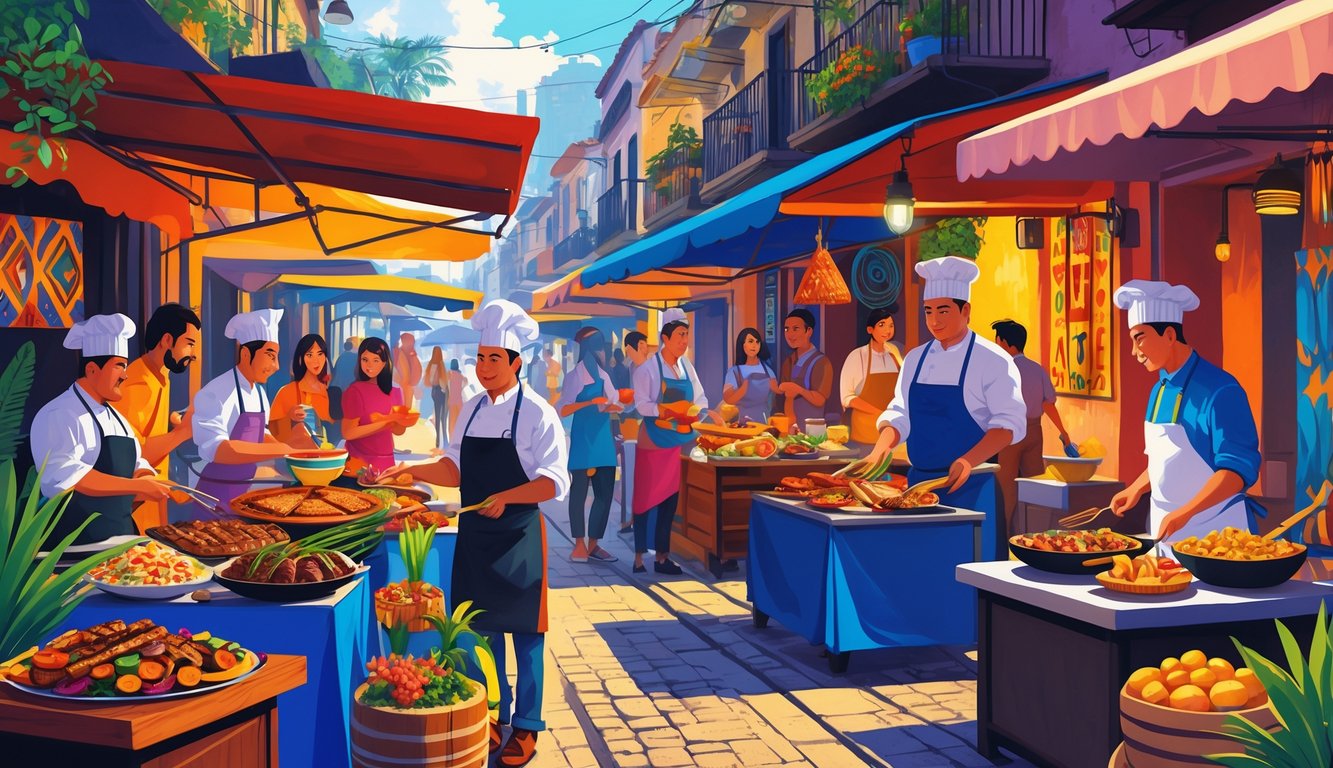Street Food Innovations and Influences

Street food in South America’s mutating so fast I can’t keep up. It’s like someone’s DJing the classics while everyone’s still dancing—black-eyed peas, beef hearts, masa, tamales, all getting remixed. Think you know what’s coming? Nope. Some chef jams in a new ingredient, TikTok explodes, and suddenly everyone’s fighting about “authenticity.”
Creative Takes on Acarajé
Acarajé’s not behaving in Bahia, and honestly, I’m here for it. Used to be: black-eyed pea fritters, fried in dendê, stuffed with vatapá and caruru. Tradition, right? Now it’s tuna tartare and avocado shoved inside, and no, I didn’t mishear that.
Heard about a stall swapping hot prawns for smoked tofu—guess vegetarians gotta sweat, too. Chef Tati Massala (she’s a big deal, apparently) boosted sales 30% after dropping an “international acarajé trio” with salmon, curry chickpeas, spicy pork. She said, “This is evolution, not disrespect.” Maybe she’s right, maybe not—who decides? My chef group chat loses its mind every time someone adds sriracha or kimchi. Meanwhile, street vendors with a propane tank are suddenly trendsetters. Everyone just keeps eating.
Modern Anticuchos
Then my cousin texts me: “Why’s beef heart at fancy restaurants again?” Like I know. Anticuchos—classic skewered offal, total street food—now show up in Lima and São Paulo fine dining spots. Cheap cuts? Not anymore.
The new thing is quinoa chimichurri, which is actually pretty good. One guy swapped ox heart for duck, didn’t apologize, got a magazine write-up. Chefs sneak in molecular tricks: edible smoke, sous-vide, and suddenly you’re paying $12 for a skewer. Grandma would be confused. Processkitchens.com says street food’s all about breaking the rules now, not asking permission—just serving the next person in line.
Tamales with a Twist
You think you know tamales? Think again. Sweet potato-mango tamales with gochujang crema hit a Rio market last week; I missed it, still mad. My first tamale was pork and masa, unwrapping the leaf while grandma yelled at me to slow down. Now? Vegan tamales in beet wrappers, kimchi in the masa, matcha-pistachio dessert versions with coconut cream. Why? No clue.
Lucia Gomez Dominguez, who runs a market stall, says her fusion tamales sell out twice as fast as the old-school ones—but she’d still pick her abuela’s mole negro. Researchers say these mashups spark constant fights over what’s “authentic.” I burned my fingers on a cheese-jalapeño tamale last year, chugged water, watched a kid Instagram his jackfruit-tamarind roll. Nobody’s keeping up. They just eat whatever looks good and argue about it later.
Regional Diversity Shaping New Culinary Trends
Bite into a smoked trout empanada and try to guess—did the chef steal that from German settlers or just binge too much sushi? That’s what’s happening everywhere in the southern cone. Kelp as a thickener? Grandmas roll their eyes, but chefs swear by it. They’ll talk up indigenous grains, then toss in Japanese yuzu for fun. Is anyone keeping track? Doubt it.
Patagonia’s Influence on the Culinary Scene
Patagonia’s not just sheep and glaciers—it’s kitchens obsessed with using whatever’s left. Lamb smoked with wild herbs, game birds drowned (okay, not literally) in berry sauces, roots that look like medicine but somehow end up in dinner. Patagonian pine nuts? People act like they’re truffle oil now. Every restaurant’s infusing them into something.
Last time I visited, the bread had moss—or maybe lichens? Chef wouldn’t say, just mumbled about “ancestral methods” and then whipped out a French sous-vide gadget. Regional diversity means you might get a perfect custard one day, then something charred under sleet the next. Sustainability’s the buzzword, but I’ve watched chefs pull weeds by the highway and call it “foraging.” Global food trend reports say Patagonia’s kitchens have basically rewritten the rules. Not sure if that’s good or bad, but honestly, at least it’s never boring.
Chile and Coastal Innovations
Alright, Chilean food—let me just start by saying, seaweed used to be “fisherman’s trash.” It’s wild. Now there are chefs, actual professionals, who show up at 5 a.m. to elbow each other for a chunk of cochayuyo or luche, which honestly, still smells like the ocean floor. I once had a kelp martini in Santiago, 2023. Not sure if I loved it or just felt like I was drinking the tide pool, but hey, points for effort. And this isn’t just some PR thing—eco-aquafarming is actually messing with what ends up on the plate, in a good way, I think? Some nights, seafood is so fresh it’s basically still twitching. And, fun fact, sometimes the guy delivering your fish is a med student who just needed gas money.
But here’s what gets me: restaurant managers parrot sustainability standards like they’re reading off a teleprompter, then hand you imported bluefin with a straight face. Coastal kitchens? They’re all over the map. You’ll get pastel de jaiba one minute (burned my tongue, as usual), then some chef tries to convince you abalone foam is a thing. The World Gastronomy Organization keeps insisting that “local ingredients and sustainable methods” are more than a trend. Maybe. I just hear it repeated at every food panel, like a broken record.
Central and Regional Dishes
So, humita. Why do people fight about humita fillings like it’s a custody battle? My neighbor swears, “If it’s not with fresh basil, it’s not humita,” then dumps mozzarella in anyway. Central South America is just chaos: one day you get quinoa stew with wild greens, next day it’s some colonial recipe that started as a joke and now everyone claims it’s “authentic.” I’ve literally seen chefs open ancient cookbooks and then ignore every single measurement.
Fusion isn’t a buzzword here; it’s survival. Even the stubborn traditionalists sneak in a splash of soy sauce. Pineapple in sopa paraguaya, though? Never. Local restaurants slap up signs—“regional freshness,” “ancestral recipe rebooted”—because apparently, that’s what sells. If you’re looking for order, forget it. Everything’s a jumble of Spanish, indigenous, and immigrant ideas. Regional dishes are less about tradition and more about whatever’s growing or trending. Quinoa ice cream? Saw it last week. Still not sure how I feel.



